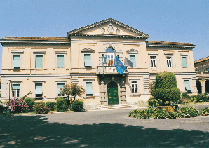Institutional sponsorship and support have been
The “International Centre for AIDS and Emerging & Re-emerging Infections” (ICAERI) has been inaugurated on March the 25th 1998, as result of an agreement between the National Institute for Infectious Diseases “Lazzaro Spallanzani”, the UNESCO and the World Foundation for AIDS Research and Prevention. ICAERI originates from the CNR-UNESCO agreement to increase the cooperation in scientific research and science communication in the field of AIDS, considering the worldwide impact of this infectious disease.
 provided by the National Research Council, the Italian Ministry of Health and the University of Rome “Tor Vergata”. Institutional links with the “Istituto Superiore di Sanità” (Rome) have also established. Moreover, additional collaborations with Italian and foreign Universities and Research Institutions are being formed. Recently, an agreement has been signed between ICAERI and the Unit for Research Diagnosis and Prevention for Tuberculosis at the “Monaldi” Hospital of Naples.
provided by the National Research Council, the Italian Ministry of Health and the University of Rome “Tor Vergata”. Institutional links with the “Istituto Superiore di Sanità” (Rome) have also established. Moreover, additional collaborations with Italian and foreign Universities and Research Institutions are being formed. Recently, an agreement has been signed between ICAERI and the Unit for Research Diagnosis and Prevention for Tuberculosis at the “Monaldi” Hospital of Naples.
The general objective of ICAERI is to promote scientific research and communication in the area of AIDS and other emerging and re-emerging infections. Special attention was focused on the support of basic research activities at the National Institute for Infectious Diseases “Lazzaro Spallanzani”. In addition to its research activities, specific services are provided by ICAERI, such as the organisation of scientific meetings, initiating research grants, short term fellowships, hosting of teaching and training groups and managing the UNESCO Chair Interdisciplinary in Biotechnology.
Within the area of AIDS and emerging infections, the principal focus of ICAERI is to understand the mechanisms of pathogenesis and the role of the immune system. The main projects are dealing with a great variety of cellular, molecular, and genetic approaches aimed to explore the interface of pathogen-host cell interactions and to dissect the molecular mechanisms that participate in regulating the immune response.
Specific areas of this research are: viral entry and pathogenesis; bacterial pathogenesis and prokaryotic cell physiology; identification of microbial virulence factors;
gene expression and cell cycle regulation; leukocyte trafficking; characterisation of tumour suppresser genes and apoptosis; lymphocyte development and differentiation; signal transduction; molecular and cellular basis of autoimmunity.
ICAERI provides a stimulating, inviting, supportive, and highly interactive scientific environment that is strongly enhanced by a significant number of internal collaborations. Research efforts are coordinated through the collaborations with national and international universities and research institutes. Furthermore,
numerous ICAERI members are also members of national and international institutes that are leaders in research and education, sharing a variety of resources and research infrastructures for basic research. Altogether, ICAERI takes actively part in research programs and grants that bring together scientists with mutual research interests, both from inside and outside the “L. Spallanzani” Institute, to work collaboratively towards specific common thematic research goals.
ICAERI organises the annual CNR-UNESCO meeting and promotes weekly journal clubs and seminaries. Speakers are invited from national and international institutions, and a forum for students, fellows and research scientists is provided to present and discuss their most recent research findings.
This annual report should give a review on the scientific activities carried out by ICAERI members, but also aims to represent a vigorous tool to promote scientific discussion, collaboration and education. For this reason, members and guests of the laboratory, collaborators at national and international level will be introduced,
and their scientific projects and related results will be reported. Moreover, the financial contributions that allow to perform the research projects at ICAERI are listed inhere.
For most of us, the time spent in the ICAERI represented the major part of the proper daily activities. Therefore, one of our objectives was also to create a stimulating and inviting atmosphere that could provide good interpersonal relationships and a sense of trust and responsibility, since we believe that these qualities are essential requirements for any efficient scientific collaboration. In this context, the scientific, clinical and administrative staff of the
“L. Spallanzani” Institute is gratefully acknowledged, as without their contribution this report would appear in a much more limited version.


